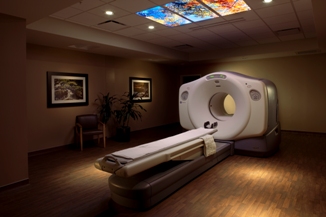
What is PET/CT?
PET stands for Positron Emission Tomography, which is a type of nuclear medicine imaging. There are many uses for PET scans, but the most common are to stage, diagnose and determine the effectiveness of cancer treatments. PET can also be used to image the brain to identify abnormalities such as seizures, tumors, Alzheimer’s disease and other forms of dementia. PET/CT uses the same machine to combine a nuclear medicine PET scan with a traditional CT (CAT) scan.
How does PET/CT work?
Before the PET scan, a technologist will ask you a series of questions, then check your blood sugar and start an IV. It’s always best to check blood sugar, whether you’re diabetic or not, to make sure levels are not too high or low. An injection of a small radioactive glucose, or sugar is given through the IV, which allows the tech to visualize your body’s metabolic during the scan. There will be a one-hour resting period in a private room after the injection and before the scan. During this hour, we would like you to try to relax and take a nap. We do not allow reading or visiting with relatives and friends after the injection. The scan lasts an average of 30 minutes to an hour, but please allow a little more than two hours for the entire exam.
What does the equipment look like?
Above you will see a picture of our PET/CT scanner. It is open at both ends and the table moves through the opening. Once in the opening, a quiet camera scans your body. We’ll place a pillow under your knees and will provide a warm blanket if you’d like one.
Learn More About PET/CT Services
Browse the documents below to learn more about PET/CT scans and studies.
- Bone Scan
- Cisternogram
- Gallium Scan
- Gastric Emptying Study
- GI Bleed, Tagged RBC Study
- Hemangioma Scan
- HIDA/DISIDA/Hepatobiliary Scan
- I-131 Ablation post Thyroidectomy
- I-131 Therapy
- I-131 Whole Body
- In-111 Tagged WBC Study
- Liver/Spleen Study
- Meckles Scan
- MUGA Scan
- Octreotide Exam
- Parathyroid/Sestamibi Scan
- Quadramet Palitive Bone Therapy
- Renal Scan
- Renal Scan With Captopril
- Renal Scan With Lasix
- Shunt Study
- Tc99m Ceretec Tagged WBC(white blood cell) Scan
- Thyroid Uptake and Scan I-123 Uptake and Scan

